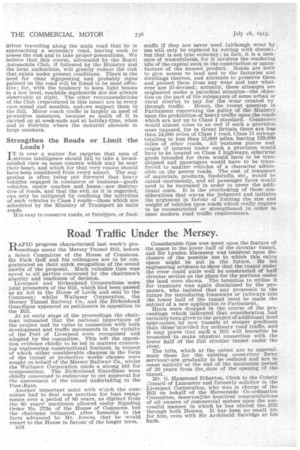Road Traffic Under the Mersey.
Page 2

If you've noticed an error in this article please click here to report it so we can fix it.
RAPID progress characterized last week's proceedings anent the Mersey Tunnel Bill, before a Select Committee of the House of Commons. Sir Park Goff and his colleagues are to be congratulated on their quick recognition of the sound merits of the proposal. Much valuable time was saved to all parties concerned by the chairman's alacrity and readiness of decision.
Liverpool and Birkenhead Corporations were joint promoters of the Bill, which had been passed as an Act in the House of Lords and sent to the Commons ; whilst Wallasey Corporation, the Mersey Tunnel Railway Co., and the Birkenhead Guardians appeared as petitioners in opposition to the Bill.
At an early stage of the proceedings the chairman intimated that the national importance of the project and its value in connection with both development and traffic movements in the vicinity of the Port of Liverpool were recognized and adopted by the committee. This left the opposition evidence chiefly to be led in matters concerning engineering constructional features, in respect of which either considerable chancres in the form of the tunnel or protective works clauses were sought on behalf of the Mersey Railway Co., whilst the Wallasey Corporation made a strong bid for compensation. The Birkenhead Guardians were chiefly concerned to endeavour to get approval for the assessment of the tunnel undertaking to the Poor tRate.
Another important point with wliich the committee had to deal was sanction for loan repayments over a period of 80 years, as distinct from the 60 years' maximum allowed under Standing Order No. 273a of the House of Commons, but the chairman intimated, after listening to the facts advanced by Mr. Jeeves. that he would report to the House in favour of the longer term. Considerable time was spent upon the feature of the space in the lower half of the circular tunnel, and Sir Lynden Macassey was insistent upon disclosure of the possible use to which this extra space might be put in the future. He led engineering evidence to show that the tunnel under the river could quite well be constructed of half circular section as the plans for the portions under the land were shown. The intention to utilize it for tramcars was again disclaimed by the promoters, who insisted that any proposals in the future for introducing tramways or railways Into the lower half of the tunnel must be made the subject of a new application to Parliament.
Hints were dropped in the course of the proceedings which indicated that consideration had certainly been given to the project of additional land approaches by new tunnels at steeper gradients than tlinse"provided for ordinary road traffic, and it may prove that such a Bill will hereafter be promoted to -make physical connection with the lower half of the full circular tunnel under the river.
The tolls, which at the outset are to approximate those for the existing cross-river ferry services;are gradually to be reduced and are to cease entirely at the end of the maximum period of 20 years from the_date of the opening of thetunnel..
Mr. G. Hammond Etherton, Clerk to the County -;_louncil of Lancaster and formerly solicitor to the .Liverpool Corporation, who was In charge of the Bill on behalf of the Merseyside Co-ordination Committee, deserves the heartiest congratulations of all owners of commercial motors upon the successful manner in which he has piloted the-Bill through both Houses. It has been no small lob for him, even with Sir Archibald Salvidge at his back.




























